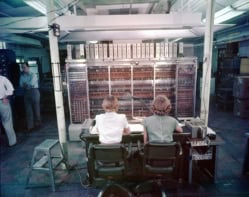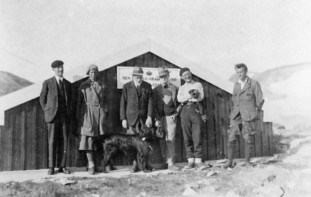Newton and the Counterfeiter
Thomas Levenson
2009 Faber and Faber
£20.00/$25.00 hb 336pp

In 1696 Isaac Newton made what seems like a bizarre career move. Abandoning Cambridge University and the mathematical pursuits that made him famous, the 53-year-old scientist upped sticks for London to become warden of the Royal Mint. Part administrator, part coining expert, and part criminal prosecutor, this new role would occupy Newton for the remaining three decades of his life.
In Newton and the Counterfeiter, Thomas Levenson explores one of the most intriguing stories from these later chapters in Newton’s career: the great scientist’s dogged pursuit of a master criminal through the streets of London in the late 1690s. London was a toxic, throbbing city in those days, already boasting about 10% of the entire British population. An additional 200–300 new arrivals wandered into its confines every day. Many of them, including Newton, were seeking new lives, careers and fortunes.
Levenson, a professor of writing at the Massachusetts Institute of Technology, establishes the story by first taking readers on a rapid romp through the first 50 years of Newton’s life. He covers the common biographical highlights, including the 1687 publication of Principia. He also touches on some of the more obscure elements of Newton’s life – his alchemy, his mysterious illness of 1693 and his curious friendship with the Swiss mathematician Nicolas Fatio de Duillier.
After these first few chapters, the reader will have enough of a portrait of Newton to appreciate his motivations in pursuing the other main character in the book – a counterfeiter and criminal mastermind named William Chaloner. The son of an impoverished weaver from the Midlands, Chaloner started out as an apprentice nail-maker. However, he soon found that hammering coins was more profitable than hammering nails. He was a master craftsman, known for his skilful counterfeits and forgeries, and in his heyday he became quite rich. He was also notoriously slippery. More than once he was thrown in prison, and more than once he managed to beat the charges and walk out a free man.
Dashing as these actions may seem, readers of Levenson’s book will not likely be left rooting for Chaloner. He was a despicable character. In addition to counterfeiting, he stole property from people and sold it back to them. He also ran a thriving sideline betraying criminals and innocent associates alike. When he lacked a conspiracy to report to the authorities, he sometimes fabricated one. Numerous people went to the gallows while Chaloner bragged openly about his rewards.
As chief prosecutor of counterfeiters, Newton was certain to clash with Chaloner sooner or later. Newton’s appointment came at a critical time for the Royal Mint. Thanks to the efforts of Chaloner and lesser crooks, the circulation of fake coins had reached epidemic proportions: by 1696 Newton himself estimated that 10% of the coins then in circulation were counterfeit.
In his efforts to rectify this, Newton exerted the same sort of profligate enthusiasm that characterized most of his career, wading “hip deep into London’s underworld”, as Levenson puts it. Newton hired undercover operators to trawl pubs and prison cells to gather information. He had himself appointed justice of the peace in seven counties so that he could operate freely in all of them. He arrested, coerced and oversaw the execution of criminals. Perhaps most importantly, he helped persuade the British government to embark on a complete recoining of the realm’s currency. The old hand-hammered coins, which were easier to fake, were taken out of circulation and replaced with the more modern industrially milled coins.
Some counterfeiters might have been deterred by this new technology. Not Chaloner. Instead, the wily criminal hatched one of the boldest criminal conspiracies in history: he petitioned parliament for access to the Mint, arguing that the new coins were insufficiently protected against counterfeiting. He suggested that he, Chaloner, be allowed to inspect the coining machines and make alterations to them as necessary – a ruse simply meant to give him unfettered access to the equipment. He was so convincing that he almost succeeded, and no doubt he would have – had it not been for Newton.
The scientist-turned-civil-servant saw right through this proposal, and Newton began a relentless campaign to bring Chaloner down. As ever, Newton approached his task with a single-minded determination. He spent months deposing witnesses and tirelessly piling up evidence against his nemesis. As Levenson puts it, Newton regarded Chaloner as “someone not merely to be stopped, but crushed”. Even so, he nearly met his match in Chaloner, who repeatedly wriggled out of seemingly impossible legal tangles.
As a backdrop to his main narrative, Levenson presents a grim but compelling picture of London life at the close of the 17th century – from the open sewers in the mean streets to the incomparably brutal Newgate Prison. He also introduces numerous colourful characters along the way. There is Jonathan Wild, who controls the London underworld; and Obadiah Lemon, a street thug who specializes in using a fishing pole to snag hats off rich people passing in the streets below. We meet Kathy Coffee, one of the chief witnesses against the counterfeiter, and the irascible “hanging judge” Salathiel Lovell. And the book is filled with many criminals like Chaloner who came willingly to London seeking their fortunes, and who (also like Chaloner) only left when they were dragged through the dirt to the hangman’s tree.
In the end, the only character in the book who really seems to prosper is Newton. In his later years he is rich, knighted and head of the Royal Society. In London, he keeps the highest company and is surrounded by admirers and fiercely loyal supporters. Chaloner, on the other hand, winds up desperate and poor, and he eventually comes to a sorry end because of the ineptitude and disloyalty of the criminal company he keeps.
Yet Newton’s nemesis remains a colourful figure. Many writers have touched upon him in books covering the end of the 17th century, and of course anyone who has read a comprehensive biography of Newton will already be acquainted with “the man clever enough to challenge Newton”, as Levenson calls him. But this fascinating new book is the first to really explore Chaloner as a compelling character in his own right – and to great effect.



